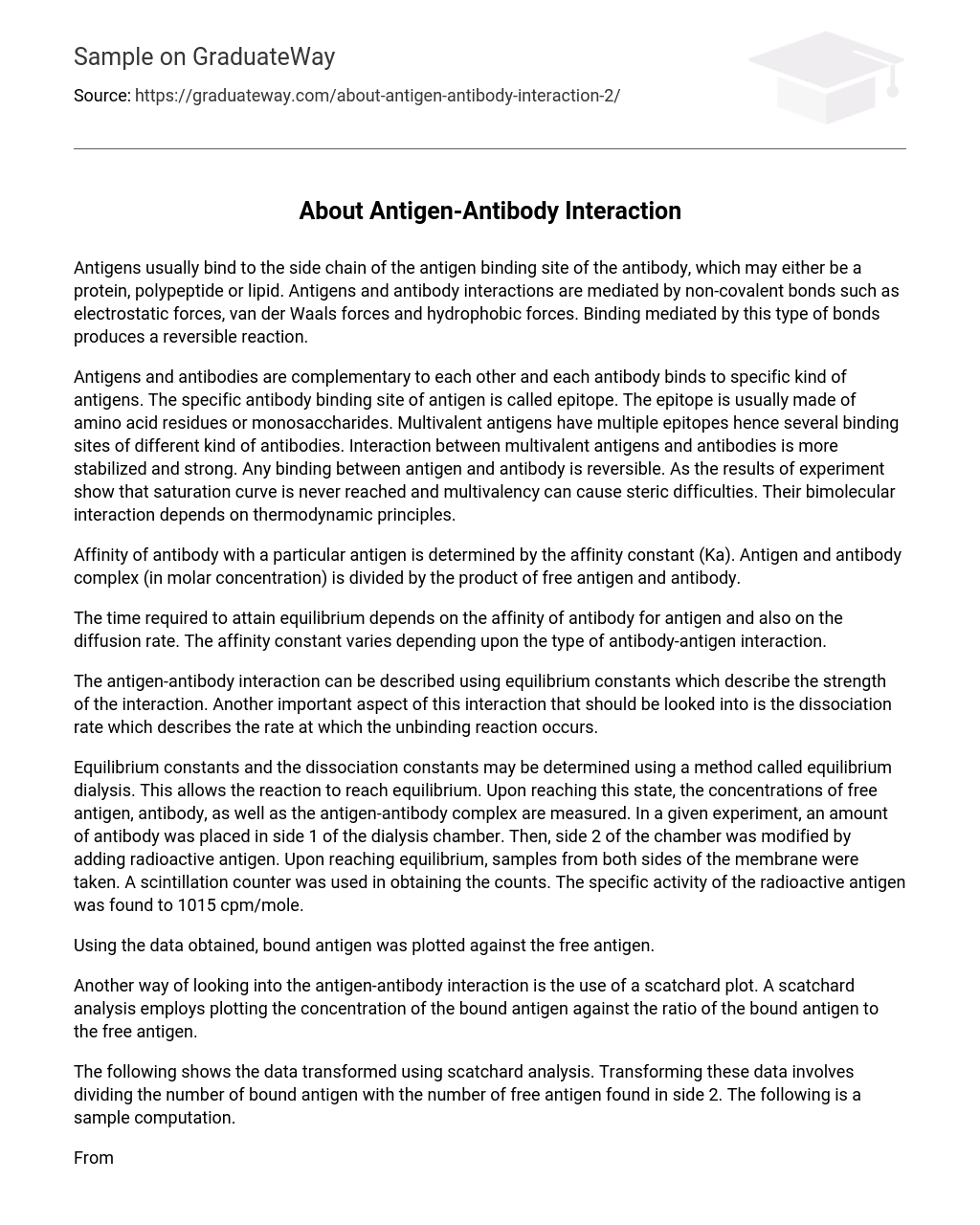Antigens usually bind to the side chain of the antigen binding site of the antibody, which may either be a protein, polypeptide or lipid. Antigens and antibody interactions are mediated by non-covalent bonds such as electrostatic forces, van der Waals forces and hydrophobic forces. Binding mediated by this type of bonds produces a reversible reaction.
Antigens and antibodies are complementary to each other and each antibody binds to specific kind of antigens. The specific antibody binding site of antigen is called epitope. The epitope is usually made of amino acid residues or monosaccharides. Multivalent antigens have multiple epitopes hence several binding sites of different kind of antibodies. Interaction between multivalent antigens and antibodies is more stabilized and strong. Any binding between antigen and antibody is reversible. As the results of experiment show that saturation curve is never reached and multivalency can cause steric difficulties. Their bimolecular interaction depends on thermodynamic principles.
Affinity of antibody with a particular antigen is determined by the affinity constant (Ka). Antigen and antibody complex (in molar concentration) is divided by the product of free antigen and antibody.
The time required to attain equilibrium depends on the affinity of antibody for antigen and also on the diffusion rate. The affinity constant varies depending upon the type of antibody-antigen interaction.
The antigen-antibody interaction can be described using equilibrium constants which describe the strength of the interaction. Another important aspect of this interaction that should be looked into is the dissociation rate which describes the rate at which the unbinding reaction occurs.
Equilibrium constants and the dissociation constants may be determined using a method called equilibrium dialysis. This allows the reaction to reach equilibrium. Upon reaching this state, the concentrations of free antigen, antibody, as well as the antigen-antibody complex are measured. In a given experiment, an amount of antibody was placed in side 1 of the dialysis chamber. Then, side 2 of the chamber was modified by adding radioactive antigen. Upon reaching equilibrium, samples from both sides of the membrane were taken. A scintillation counter was used in obtaining the counts. The specific activity of the radioactive antigen was found to 1015 cpm/mole.
Using the data obtained, bound antigen was plotted against the free antigen.
Another way of looking into the antigen-antibody interaction is the use of a scatchard plot. A scatchard analysis employs plotting the concentration of the bound antigen against the ratio of the bound antigen to the free antigen.
The following shows the data transformed using scatchard analysis. Transforming these data involves dividing the number of bound antigen with the number of free antigen found in side 2. The following is a sample computation.
From the transformed data above, a scatchard plot may then be constructed with the ratio of the bound over free on the y-axis. The x-axis contains the concentration of bound antigens.
The scatchard plot allows for the determination of the affinity constant of the antibody (Ka). By getting the slope of the generated line, a constant is obtained. The negative reciprocal of this constant gives us a value corresponding to Ka. By using two points from the line, a slope is obtained using the following computations. Getting the negative reciprocal of – 0.013 gives us the affinity constant 76.92.
If affinity constant is high it means that affinity of antibody for antigen is also high and more antibodies are attracted towards antigen binding sites. If affinity constant is low it means that affinity of an antibody for an antigen is low and fewer antigen binding sites are occupied by antibodies. Avidity determines the stabilization of the antigen-antibody complex. Cross reactivity is the binding of antibody to the epitope of another antigen. This only happens when the stabilization of the antigen-antibody complex is not very strong or specificity of antibodies is not very strong for particular type of antigens but it can bind with different antigens with somewhat identical epitopes.
References
- Antigen antibody interaction. http://www.chemicon.com/resource/ANT101/a1.asp
- Antigen-antibody interaction. www.lclark.edu/~reiness/immuno/lectures/Ag-Ab%20Interactions.pdfvv





